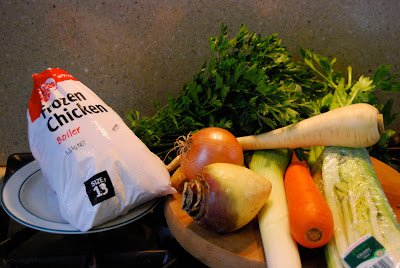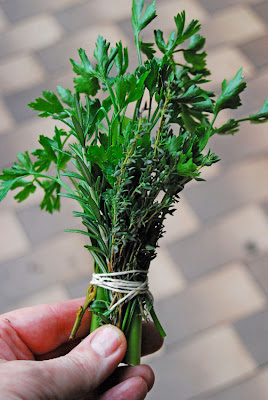With more than a week of relentlessly wet weather drenching the garden and ruining that kind of fun, there is but one thing for this boy to do – cook! But something new, something different. For our 20th wedding anniversary last year, Pammy bought me a lovely Scanpan Tagine plus a big, beautiful Moroccan cookbook, and that's where I went to for inspiration. Hmmm, "chermoula" – a classic North African spice/herb blend – that sounds nice. I have most of the ingredients either in the pantry or growing in the garden. Let's go.
 I'll give the recipe at the end, but here it is in its prettiest stage, just after I added ground cumin, paprika and cayenne pepper to the garlic. But I am already getting ahead of myself.
I'll give the recipe at the end, but here it is in its prettiest stage, just after I added ground cumin, paprika and cayenne pepper to the garlic. But I am already getting ahead of myself. Here's the makings of my chermoula. Coriander, parsley and lemon (all home-grown), garlic, paprika, cumin, cayenne pepper, olive oil, and mortar and pestle.
Here's the makings of my chermoula. Coriander, parsley and lemon (all home-grown), garlic, paprika, cumin, cayenne pepper, olive oil, and mortar and pestle. Oops, forgot to mention the salt. In fact the salt is a magic ingredient, as it helps to turn garlic to soft mush with just a few thumps of the pestle. It's just like a little chemistry lesson on its own, the way salt disintegrates garlic.
Oops, forgot to mention the salt. In fact the salt is a magic ingredient, as it helps to turn garlic to soft mush with just a few thumps of the pestle. It's just like a little chemistry lesson on its own, the way salt disintegrates garlic. Then add chopped parsley and chopped coriander, plus some lemon juice, then at the end, some olive oil.
Then add chopped parsley and chopped coriander, plus some lemon juice, then at the end, some olive oil. Traaa daaaa! Chermoula. It wasn't that hard to do, but the trick is to not add all the bulky parsley and coriander in one go. I added it in small batches and it quickly pounded down. Total time taken to pound it all down to a paste was about 5 minutes. Good village-style peasant work, and good rainy-day work, too. I suppose you could do it all in a blender, but it wouldn't come out like this, with the little chunky bits here and there.
Traaa daaaa! Chermoula. It wasn't that hard to do, but the trick is to not add all the bulky parsley and coriander in one go. I added it in small batches and it quickly pounded down. Total time taken to pound it all down to a paste was about 5 minutes. Good village-style peasant work, and good rainy-day work, too. I suppose you could do it all in a blender, but it wouldn't come out like this, with the little chunky bits here and there. The next step is to coat the "meat" with some of the chermoula. This in fact is a beautiful fish called Bass Grouper (it's similar to blue-eye cod). It comes as big, thick steaks from which I remove the bones, then cut it into chunks. It holds together beautifully in cooking and remains moist, never seems to go dry. However, this recipe would work equally well with other meats, such as chunks of chicken or pork, for example.
The next step is to coat the "meat" with some of the chermoula. This in fact is a beautiful fish called Bass Grouper (it's similar to blue-eye cod). It comes as big, thick steaks from which I remove the bones, then cut it into chunks. It holds together beautifully in cooking and remains moist, never seems to go dry. However, this recipe would work equally well with other meats, such as chunks of chicken or pork, for example. Next, the vegies. Here, I cut up slices of potato, red and yellow capsicum, zucchini, and tipped in a can of diced tomatoes, then stirred in the remainder of the chermoula and a few leftover scraps of parsley and coriander.
Next, the vegies. Here, I cut up slices of potato, red and yellow capsicum, zucchini, and tipped in a can of diced tomatoes, then stirred in the remainder of the chermoula and a few leftover scraps of parsley and coriander. Big spoon to toss all the vegies together, plus a grind each of salt and pepper, and a drizzle of olive oil.
Big spoon to toss all the vegies together, plus a grind each of salt and pepper, and a drizzle of olive oil. Into the tagine I scooped in half the vegies to layer the bottom, then covered these with all the fish (which had been marinating in the chermoula for the half-hour it took to prepare all the vegies), then I covered the fish with the rest of the vegies. Lid on. Bake one hour at 180°C (350°F) and it's ready. Serve with couscous on the side.
Into the tagine I scooped in half the vegies to layer the bottom, then covered these with all the fish (which had been marinating in the chermoula for the half-hour it took to prepare all the vegies), then I covered the fish with the rest of the vegies. Lid on. Bake one hour at 180°C (350°F) and it's ready. Serve with couscous on the side.Halfway through eating it, I said to Pam: "Oh oh, I forgot to take a photo of the finished dish". So you'll just have to imagine the results. It tasted yummy, though. Anyway, here's the amounts for the chermoula. As for the vegies, I just made all that bit up as I went along.
Chermoula
2 garlic cloves, roughly chopped
1/2 teaspoon salt
3 tablespoons chopped flat-leaf parsley
3 tablespoons chopped coriander (cilantro)
2 teaspoons paprika
2 teaspoons ground cumin
1/2 teaspoon cayenne pepper
1 tablespoon lemon juice
2 tablespoons olive oil
Method: pound the garlic with the salt until mushy, then add the paprika, cumin, cayenne pepper and lemon juice to make a paste. Then add the parsley and coriander in batches, and pound until reduced in bulk. Finally, work the olive oil into the mixture in stages, until blended nicely.
(For Aussie readers, this recipe is from the excellent book, "The Food of Morocco" by Tess Malloss, published by Murdoch Books, ISBN 9781741960341).





































